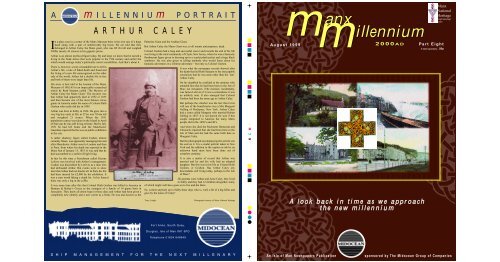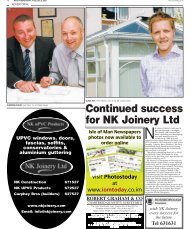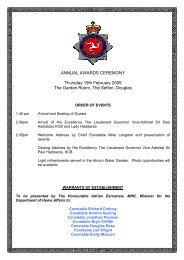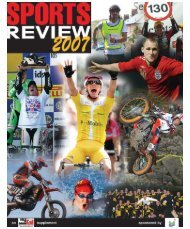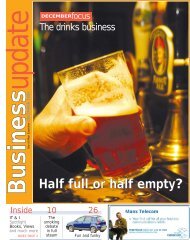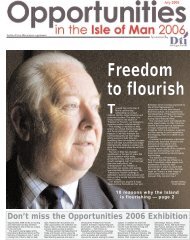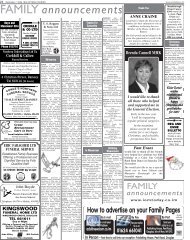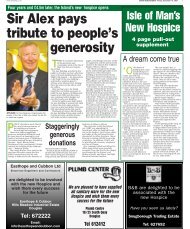m - Isle of Man Today
m - Isle of Man Today
m - Isle of Man Today
Create successful ePaper yourself
Turn your PDF publications into a flip-book with our unique Google optimized e-Paper software.
A m ILLENNIUm PORTRAIT<br />
A R T H U R C A L E Y<br />
In a glass case in a corner <strong>of</strong> the <strong>Man</strong>x Museum there is the iron cast <strong>of</strong> a huge<br />
hand along with a pair <strong>of</strong> unbelievably big boots. We are told that they<br />
belonged to Arthur Caley, the <strong>Man</strong>x giant, who was 8ft 2in tall and weighed<br />
590lbs (nearly 43 stones) in his gigantic prime.<br />
Arthur is an almost mythical figure today. By and large we know that he earned a<br />
living in the freak shows that were popular in the 19th century and earlier but<br />
which would outrage today’s politically correct sensibilities. And that’s about it.<br />
There is, however, a truly remarkable tale to tell in<br />
Arthur’s life, a tale <strong>of</strong> faked death and fraud and<br />
the living <strong>of</strong> a new life unrecognised on the other<br />
side <strong>of</strong> the world. Arthur led a double life in fact<br />
and both <strong>of</strong> them were larger than life.<br />
His story is best told in the Journal <strong>of</strong> the <strong>Man</strong>x<br />
Museum <strong>of</strong> 1962-63 in an impeccably researched<br />
article by Ruth Serjeant called ‘The Mystery <strong>of</strong><br />
Arthur Caley the <strong>Man</strong>x Giant.’ The mystery was<br />
that Arthur had apparently died in 1852 or 1853<br />
and then became one <strong>of</strong> the most famous circus<br />
giants in America under the name <strong>of</strong> Colonel Ruth<br />
Goshen who really did die in 1889.<br />
Arthur was born in Sulby in 1824. He grew into a<br />
very big boy early in life; at 22 he was 7ft 6in tall<br />
and weighted 21 stones. When the 1851<br />
population census was taken in the Island in April<br />
<strong>of</strong> that year he was still living at home. But by July<br />
1851 he had left home and the <strong>Man</strong>chester<br />
Guardian reported that he was on public exhibition<br />
in the city.<br />
A rather shadowy figure called Cashen, almost<br />
certainly <strong>Man</strong>x, was apparently managing him and<br />
after <strong>Man</strong>chester Arthur went to London and then<br />
to Paris, from where his death was reported in the<br />
<strong>Man</strong>x Sun <strong>of</strong> January 15, 1853. It was said that he<br />
had succumbed to a surfeit <strong>of</strong> high living.<br />
In fact by this time a Frenchman called Etienne<br />
Lefevre was involved with Arthur’s management.<br />
Cashen was discredited by Lefevre as a man who<br />
had defrauded Arthur. But events were to show<br />
later that Arthur had not died at all. In Paris his life<br />
had been insured for £2,000 by his exhibitors. It<br />
was a sum worth faking a death for. At his funeral<br />
there was only a log in the c<strong>of</strong>fin.<br />
It was some time after this that Colonel Ruth Goshen was billed in America in<br />
Barnum & Bailey’s Circus as the youngest <strong>of</strong> a family <strong>of</strong> 14 giants born in<br />
Jerusalem. They knew all about hype in those days and Arthur had been given a<br />
completely new identity and a new career as a freak. He was also known as the<br />
Palestine Giant and the Arabian Giant.<br />
But Arthur Caley the <strong>Man</strong>x Giant was, to all intents and purposes, dead.<br />
Colonel Goshen had a long and successful career and towards the end <strong>of</strong> his life<br />
was living in the rural community <strong>of</strong> Clyde, New Jersey, where he was a famously<br />
flamboyant figure given to dressing up in a scarlet plush jacket and a huge black<br />
sombrero. He was also given to telling anybody who would listen about his<br />
fantastic adventures in a lifetime adventure – but only as Colonel Goshen.<br />
It was what the newspaper records showed after<br />
his death that led Ruth Serjeant to the inescapable<br />
conclusion that he was none other than the ‘late’<br />
Arthur Caley.<br />
On his deathbed he confided in the minister who<br />
attended him that he had been born in the <strong>Isle</strong> <strong>of</strong><br />
<strong>Man</strong>, not Jerusalem. (The minister, incidentally,<br />
was James Lefevre; if it was a coincidence it was<br />
an unlikely one). It also emerged that Colonel<br />
Goshen had been the same age as Arthur Caley.<br />
But perhaps the clincher was the fact that in his<br />
will one <strong>of</strong> the beneficiaries was a Mrs Margaret<br />
Gelling <strong>of</strong> Rochester, New York. Arthur Caley<br />
had a sister called Margaret who married Robert<br />
Gelling in 1835. It is not known for sure if this<br />
couple emigrated to America but many <strong>Man</strong>x<br />
people did in the 1830’s and 40’s.<br />
And when she died the Rochester Democrat and<br />
Chronicle reported that she had been born in the<br />
<strong>Isle</strong> <strong>of</strong> <strong>Man</strong> and she had the same birth date as<br />
Margaret Caley.<br />
But the photograph accompanying this article sets<br />
the seal on it. It is a studio portrait taken in New<br />
York and the addition to the caption in ink by an<br />
unknown hand must have been done out <strong>of</strong><br />
complete certainty.<br />
It is also a matter <strong>of</strong> record that Arthur was<br />
married and he and his wife had an adopted<br />
daughter. But this was in his life as Colonel Ruth<br />
Goshen, or Goshon. Has Arthur Caley any<br />
descendants still living today, perhaps in the <strong>Isle</strong><br />
<strong>of</strong> <strong>Man</strong>.?<br />
His parents were Arthur and Anne Caley, they lived<br />
in Sulby and they had 12 children altogether, many<br />
<strong>of</strong> which might well have gone on to live and die there.<br />
So, is there anybody up in Sulby these days who is, well, a bit <strong>of</strong> a big feller and<br />
goes by the name <strong>of</strong> Caley?<br />
Terry Cringle<br />
Photograph courtesy <strong>of</strong> <strong>Man</strong>x National Heritage<br />
K C M Y<br />
m<br />
August 1999m<br />
m anx<br />
illenniumPart 2000AD<br />
Eight<br />
A l o o k b a c k i n t i m e a s w e a p p r o a c h<br />
t h e n e w m i l l e n n i u m<br />
If sold separately – 50p<br />
<strong>Man</strong>x<br />
National<br />
Heritage<br />
Eiraght Ashoonagh<br />
Vannin<br />
Fort Anne, South Quay,<br />
Douglas, <strong>Isle</strong> <strong>of</strong> <strong>Man</strong> IM1 5PD<br />
Telephone 01624 649649<br />
S H I P<br />
M A N A G E M E N T F O R T H E N E X T M I L L E N A R Y<br />
An <strong>Isle</strong> <strong>of</strong> <strong>Man</strong> Newspapers Publication<br />
sponsored by The Midocean Group <strong>of</strong> Companies
m<br />
2 anxmillennium<br />
manxmillennium<br />
23<br />
Peter Kelly writes<br />
As we accelerate ever more quickly<br />
towards the end <strong>of</strong> the century, we<br />
should take some time to reflect on<br />
the rich heritage <strong>of</strong> the <strong>Isle</strong> <strong>of</strong> <strong>Man</strong> and some<br />
<strong>of</strong> the characters who have helped shape the<br />
local culture. Important figures from the<br />
Island’s past have featured in each issue <strong>of</strong><br />
this Midocean-sponsored millennium<br />
supplement and the focus is on a man whose<br />
boots would be hard to fill.<br />
Arthur Caley was known as the <strong>Man</strong>x Giant<br />
and was more than eight feet tall and weighed<br />
nearly 43 stone. Read about his eventful life<br />
on the back page <strong>of</strong> this issue and then pay a<br />
visit to the <strong>Man</strong>x Museum in Douglas where a<br />
pair <strong>of</strong> Arthur’s enormous boots can be found.<br />
Thinking big in terms <strong>of</strong> international shipping<br />
activities yet maintaining the closeness <strong>of</strong> the<br />
family business is a balance we strive to<br />
achieve at Midocean. At the start <strong>of</strong> the year,<br />
we acquired our 100th vessel. We know have<br />
120 vessels and we have just reached another<br />
milestone - the number <strong>of</strong> employees at our<br />
Fort Anne headquarters now numbers more<br />
than one hundred.<br />
We are proud <strong>of</strong> the fact that a high<br />
percentage <strong>of</strong> our workforce is local and<br />
therefore already deeply involved in Island<br />
life. A social club was established to build on<br />
this solid foundation and is going from<br />
strength to strength with several fund raising<br />
events for charity already under its belt. So,<br />
we are satisfied that the continuing expansion<br />
<strong>of</strong> Midocean can be accommodated within a<br />
close-knit community, with benefits for<br />
everyone involved.<br />
I hope you enjoy the eighth edition <strong>of</strong> <strong>Man</strong>x<br />
Millennium.<br />
Christos Ashiotis<br />
<strong>Man</strong>aging Director<br />
The number <strong>of</strong> calls<br />
following the publication<br />
<strong>of</strong> edition 7 were less than<br />
usual but I think I posed fewer<br />
questions than usual. In this<br />
edition you will find 50 views,<br />
taken mainly from magic<br />
lantern slides and glass<br />
negatives but a handful from<br />
photographic prints.<br />
I have introduced some<br />
photgraphs taken by Mr<br />
Southward which centre<br />
mainly on the north <strong>of</strong> the<br />
Island. In the September<br />
edition the majority <strong>of</strong> the<br />
views will come from the<br />
Southward collection with the<br />
remainder being from<br />
photographs given to the <strong>Man</strong>x<br />
Museum Library <strong>of</strong> recent.<br />
Unlike the photographs that<br />
appear in my weekly<br />
‘Nostalgia’ column in the<br />
<strong>Man</strong>x Independent it is<br />
possible to order photographs<br />
from the <strong>Man</strong>x Millennium<br />
series. Simply go along to the<br />
<strong>Man</strong>x Museum Library and<br />
quote the number which<br />
appears with the caption to the<br />
view in which you have an<br />
interest.<br />
It is suprising but since this<br />
series began in January<br />
readers have discovered<br />
photographs <strong>of</strong> themselves,<br />
their children, their partenrs<br />
and their grandparents not to<br />
mention their houses or the<br />
street in which they were born.<br />
The first piece <strong>of</strong> information<br />
related to previous editions<br />
brought to my attention was<br />
the identity <strong>of</strong> J.W. Birch who<br />
handed in to the <strong>Man</strong>x Museum<br />
photographs taken in the 1950s<br />
<strong>of</strong> such things as power<br />
stations, brickworks, river<br />
widenings etc. It transpires<br />
that he was a PhD., and<br />
sometime lecturer in<br />
Geography at the University <strong>of</strong><br />
Bristol. In 1964 he published a<br />
book entitled “The <strong>Isle</strong> <strong>of</strong> <strong>Man</strong><br />
- a Study in Economic<br />
Geography.” In his photograph<br />
<strong>of</strong> the widening <strong>of</strong> the Sulby<br />
River on page 5 (B) <strong>of</strong> the last edition the<br />
digger driver’s name should have read<br />
Craine not Crowe (my writing I’m afraid). I<br />
wonder how many readers realised that the<br />
photographs <strong>of</strong> Douglas beach on page 3<br />
(A) was printed in reverse - it was alright<br />
on the original printout.<br />
(A)<br />
(B)<br />
(C)<br />
(D)<br />
(E)<br />
(F)<br />
On page 6 (C) the photograph<br />
<strong>of</strong> the Ramsey Quayside<br />
brought a comment from two<br />
northside readers that the<br />
railway lines only went as far<br />
as the bend by the Mitre and<br />
not as far as the fish steps as<br />
quoted in an authoriative<br />
railway book.<br />
The cottage at the top <strong>of</strong> page<br />
8 (D) was described as Jenny<br />
Nell’s which is was how it has<br />
been catalogued <strong>of</strong> recent but I<br />
am advised that it should read<br />
Jemmy, that is Jemmy son <strong>of</strong><br />
Nell.<br />
The mill on page 11 has been<br />
identified as being at Sir<br />
George’s Bridge, Abbeylands.<br />
On page 12 (E) was a view <strong>of</strong><br />
the green at Maughold. It<br />
transpires that the three<br />
children in the photograph are<br />
the daughters <strong>of</strong> Mr Craine<br />
the grave digger who lived in a<br />
house next to the vicarage.<br />
Beneath the sundial is Janie,<br />
on the grass is Lily and<br />
walking towards the church is<br />
Jessie.<br />
The old cottages on page 14<br />
(F) include Mona Cottage<br />
which is the one with the<br />
integral door surround. This<br />
was suggested by the late Tom<br />
Cashin to have been one <strong>of</strong> the<br />
original houses <strong>of</strong> the village,<br />
its floor level is about a foot<br />
below street level. The shop<br />
and house built by Daniel<br />
Kelly dates from 1910 and the<br />
house was for Daniel himself,<br />
it did not become the vicarage<br />
until many years later. It<br />
ceased to serve that purpose in<br />
1980.<br />
Finally the ‘Old Chapel’ on<br />
(G) page 16 (F), which is<br />
described in ‘A History <strong>of</strong> Kirk<br />
Maughold’ by William and<br />
Constance Radcliffe. The site<br />
was purchased in January 1836<br />
and a school house was<br />
erected on the site. This is the<br />
building in the photograph.<br />
This was prior to the erection <strong>of</strong> Christ<br />
Church at the Dhoon in 1854-5 and so the<br />
school room was used as a temporary<br />
chapel as well.<br />
Now read on and enjoy the pictures.<br />
K C M Y<br />
Mr Southward’s camera has<br />
captured Ned Quayle on<br />
his father’s (R.E. Quayle)<br />
delivery cart, On the vehicle it<br />
says family grocer and the 1894<br />
directory lists Edward Quayle as<br />
being grocer, wine and spirit<br />
merchant <strong>of</strong> the Market Place,<br />
Ramsey. The question is, where is<br />
the row <strong>of</strong> whitewashed cottages?<br />
Southward Box 1 No 8<br />
West Craig Brickworks is<br />
the subject <strong>of</strong> this<br />
Southward photograph <strong>of</strong><br />
which the glass negative is held<br />
in the <strong>Man</strong>x Museum Library<br />
There were other brickworks at<br />
Regaby Beg, Ballacorrey and St<br />
Judes. This particular brickworks<br />
was stated in 1900 with the<br />
intention <strong>of</strong> producing 5 million<br />
bricks a year as well and<br />
drainpipes, ro<strong>of</strong> tiles, ridge tiles,<br />
floor tiles etc, It employed 14 men<br />
and finished bricks were loaded into<br />
stiff carts to be taken to Sulby<br />
Railway Station for shipment to<br />
Douglas. Southward Box 1 No 9
m<br />
22 anxmillennium<br />
manx illennium<br />
3<br />
m<br />
This photograph was taken on 18th August<br />
1934 by D. L. Hemmingway <strong>of</strong> Co.<br />
Armagh and shows the boating pool on<br />
Douglas Promenade. I included it partly<br />
because the size <strong>of</strong> the pool is now much<br />
reduced but mainly because it shows an art<br />
deco light fitting which you don’t see very<br />
<strong>of</strong>ten in photographs. A short while ago a<br />
carrier bag full <strong>of</strong> old newspaper cuttings was<br />
left in my porch, included was a special<br />
supplement from the <strong>Isle</strong> <strong>of</strong> <strong>Man</strong> Examiner<br />
issued in conjunction with the opening <strong>of</strong> the<br />
new Loch Promenade and Marine Gardens on<br />
23rd June 1934. From that I can tell you that the<br />
shelters at either end <strong>of</strong> the model yachting pond<br />
were built by W. E. Hampton Cowell <strong>of</strong><br />
Westminster Terrace using stone from the<br />
Ballajora quarry with ro<strong>of</strong>s <strong>of</strong> pitch pine covered<br />
in sheet copper. The same firm also built the<br />
Filterhouse for Douglas Corporation Water<br />
Department in Greenfield Road. The other<br />
shelters on the promenade were built by Creer<br />
Brothers. Photo No 8<br />
The ‘Great Snow’ <strong>of</strong> 1895 didn’t<br />
just happen in Ramsey and<br />
Castletown; here we have a very<br />
rare shot <strong>of</strong> what happened in Douglas.<br />
True the snow is not so deep as some <strong>of</strong><br />
those drifts that have appeared in<br />
photographs in other editions <strong>of</strong> ‘<strong>Man</strong>x<br />
Millennium’ but here we have it on<br />
Douglas Promenade. Taken from a faded<br />
print given to the <strong>Man</strong>x Museum by the<br />
late Percy Coupe on 20th July 1963, the<br />
cameraman has captured snow<br />
clearance so the horse tram can get<br />
through. We tend to forget that they were<br />
once a means <strong>of</strong> public transport rather<br />
than a tourist attraction. It linked the<br />
electric railway with the town so shoppers<br />
could come in from Ramsey, Maughold,<br />
Lonan and Laxey. Even the people <strong>of</strong><br />
Onchan would descend Summerhill or<br />
Port Jack to get the horse tram into town.<br />
Faint in the background is the Douglas<br />
Bay Hotel which opened in 1894 and was<br />
lit by electricity supplied by the electric<br />
railway company. PG/510/3<br />
This different view <strong>of</strong><br />
the Ellan Vannin has<br />
come to the <strong>Man</strong>x<br />
Museum collection <strong>of</strong> recent<br />
via Tony Pass. On board<br />
appear to be territorial<br />
soldiers, the pantechnicon<br />
possibly containing the tents<br />
and camp gear. It is when you<br />
see views like this that you<br />
realise how small the ship was<br />
and how little the<br />
accommodation for passengers<br />
for, like the Ben-my-Chree <strong>of</strong><br />
today, she was built to be the<br />
winter daily runner <strong>of</strong><br />
passengers and cargo on the<br />
one ship gap. Photo No 5<br />
To many readers this old boy will<br />
be familiar although I thought<br />
this particular close up <strong>of</strong> him<br />
was a bit different. Notice how his<br />
braces are only held on one button each<br />
side and see how the wallpaper is torn<br />
where it has been pasted over the rough<br />
walls <strong>of</strong> the cottage. The subject <strong>of</strong> this<br />
view is John Kinnish, born in 1839 and he<br />
lived in a thatched cottage on the road<br />
into Ramsey at Ballure. Near the<br />
entrance was a stone horse trough which<br />
is still visible particularly in the winter<br />
months when the foliage dies down. After<br />
Hall Caine’s book ‘The <strong>Man</strong>xman’ was<br />
published Cowen the Ramsey<br />
photographer was commissioned to take<br />
photographs to illustrate an American<br />
version (see page 14 Edition 7 and page 8<br />
Edition 6). John Kennish or as he was<br />
known by his nicknames ‘Jackie Hoodin’<br />
or ‘Jackie Ballure’ was photographed as<br />
‘Old Pete’ or Peter Quilliam and his<br />
cottage became the home <strong>of</strong> Hall Caine’s<br />
character. MNH/pic/4238<br />
Work stops for the<br />
photographer in this<br />
print<br />
entitled<br />
Knocksharry Mill Day. The<br />
farm is considerably larger<br />
today than it was when the<br />
photograph was taken, now it<br />
has a new range <strong>of</strong> farm<br />
buildings as well as a new house.<br />
Perhaps there is a reader who<br />
can identify the traction engine,<br />
mill and maybe even the workers<br />
Photo No 1<br />
An unusual subject for a photograph but it was<br />
taken by P. M. C. Kermode the Ramsey<br />
advocate who became the first Director <strong>of</strong><br />
the <strong>Man</strong>x Museum in 1922 when it opened but he<br />
had been Secretary to the <strong>Man</strong>x Museum and<br />
Ancient Monuments Trustees from 1896. The chairs<br />
are lined up outside the ancient farmhouse at<br />
Claghbane, Maughold. The chair on the left is a<br />
jointed chair which bears the inscription MC 1685<br />
and bequeathed to the museum trustees by Miss<br />
Christian <strong>of</strong> Baldromma, Maughold. The chair in<br />
the centre also bears an inscription although this is<br />
not jointed apparent in the picture. ‘J.C. 19 March<br />
1723’. This could well be carved to commemorate the<br />
birth <strong>of</strong> a child who was to receive the chair. The<br />
chair was donated to the <strong>Man</strong>x Museum by the<br />
Kermode family <strong>of</strong> Claghbane. The remaining chair<br />
is also a jointed armchair <strong>of</strong> probable 18th century<br />
origin but I invite your comments. MNH/pic/4309
m<br />
4 anxmillennium<br />
manx illennium<br />
21<br />
m<br />
The title to this view<br />
is a ‘<strong>Man</strong>x Wedding’<br />
but no further<br />
details are given as to<br />
where or when. There’s a<br />
lot <strong>of</strong> hat raising and<br />
cheering going on. There<br />
was a <strong>Man</strong>x Wedding at<br />
Lezayre as part <strong>of</strong> the<br />
Heritage Year (1986)<br />
celebrations put on by the<br />
Lezayre Heritage<br />
Committee. <strong>Man</strong>y will<br />
recall a <strong>Man</strong>x Wedding in<br />
Laxey in the 1950s –<br />
probably to coincide with<br />
the centenary <strong>of</strong> the great<br />
Laxey Wheel in 1954. Some<br />
<strong>of</strong> the customs still take<br />
place at everyday<br />
weddings. It used to be a<br />
custom for newly married<br />
couples in Douglas to walk<br />
around the lighthouse at<br />
the end <strong>of</strong> the Red Pier<br />
then the quayside hobblers<br />
would hold a rope to block<br />
their passage until the<br />
groom coughed up some<br />
coins. The rope and<br />
throwing shining pennies<br />
was used as recent as 7th<br />
August this year when<br />
Joanne Garrett and John<br />
Kelly were married at St<br />
Mary’s Church. Returning<br />
to the photograph, can any<br />
reader identify the location<br />
<strong>of</strong> this event?<br />
MNH/pic/4324<br />
Iassume the centre post into<br />
which the large wooden gates<br />
fastened actually lifted out when<br />
they went to launch the lifeboat. This<br />
lantern slide view shows the Douglas<br />
lifeboat house <strong>of</strong> 1896 which was built<br />
to the designs supplied free <strong>of</strong> charge<br />
by Mr Rennison the architect. He<br />
came to the Island at the time <strong>of</strong><br />
designing the Villiers Hotel just over<br />
20 years earlier and designed many<br />
<strong>of</strong> the entertainment buildings in<br />
Douglas as well as houses, shops etc<br />
etc. He was probabl;y the most<br />
prolific architect <strong>of</strong> his time yet he<br />
lies in an unmarked grave in the<br />
Borough Cemetery. The previous<br />
lifeboat house was a traditional stone<br />
built building and was located on the<br />
shore at Harris Promenade roughly in<br />
line with where the Sefton now stands.<br />
This building is in the Harbour<br />
Commissioners’ yard on The Approach<br />
Road which leads to the Battery Pier.<br />
There was a slipway set against the<br />
harbour wall at The Croak and the<br />
lifeboat, which weighed 11 tons, had to<br />
be pulled across the road and then<br />
lined up with the slipway. When she<br />
returned from service it took six pairs<br />
<strong>of</strong> horses to pull her back up. In 1924 a<br />
new lifeboat house (the present one)<br />
was opened almost directly opposite<br />
this building. MNH/pic/1002<br />
The subject matter <strong>of</strong> this lantern<br />
slide given to the <strong>Man</strong>x Museum in<br />
1952 by Major Harris is ‘Dick<br />
Curphey, fisherman <strong>of</strong> Douglas’ A note<br />
on the slide says he was going around<br />
with a basket <strong>of</strong> fish on his back 30-40<br />
years ago. Whether this meant 30-40<br />
years before 1952 or before the slide was<br />
taken is hard to establish. Perhaps<br />
there is a reader who can advise or tell<br />
something more about Dick Curphey<br />
MNH/pic/4222.<br />
Aschool sports team, enough<br />
players for rugby but it is a<br />
football in the hands <strong>of</strong> the lad in<br />
the middle. On the jumpers are the<br />
initials VCFC which stands for Victoria<br />
College Football Club and on the back <strong>of</strong><br />
this recently donated photograph it says<br />
1882-3 season. On the floor is an animal<br />
skin and a bowler hat but why I don’t<br />
know. The Victoria College was in Victoria<br />
Road, Douglas. According to Canon Hinton<br />
Bird’s book ‘An Island that led’ a history <strong>of</strong><br />
<strong>Man</strong>x Education it was founded in 1881 by<br />
Richard Farrell BA LLD. He had<br />
previously been vice principal <strong>of</strong> a large<br />
London school and in setting up the college<br />
was assisted by J.H. Hopkinson <strong>of</strong> Lincoln<br />
College, Oxford. Canon R. D. Kermode,<br />
well known vicar <strong>of</strong> Lezayre up to the time<br />
<strong>of</strong> the second world war was one <strong>of</strong> the<br />
early pupils here who went on to<br />
Cambridge. By 1884 the exam results<br />
from Victoria College outperformed King<br />
Williams College! Farrell retired in 1892<br />
and the college eventually closed in the<br />
first decade <strong>of</strong> the present century<br />
Photo No 4.
20<br />
m<br />
anxmillennium<br />
m<br />
anxmillennium<br />
5<br />
Douglas is the location <strong>of</strong> this picture<br />
below which is taken from an album<br />
<strong>of</strong> snapshots recently given to the<br />
<strong>Man</strong>x Museum and which is yet to be<br />
properly catalogued so here is a preview for<br />
you. It shows Barrack Street so named<br />
because <strong>of</strong> the presence <strong>of</strong> a barracks at the<br />
far end <strong>of</strong> this thoroughfare where it met<br />
Hanover Street which is now called Lord<br />
Street. The pedimented building on the left<br />
was built in 1839 as St George’s Church Infant<br />
School and Sunday School. <strong>Man</strong>y will recall it<br />
however as the Barrack Street Mission Hall.<br />
<strong>Today</strong> it is the Tardis nightclub. The houses on<br />
the right were demolished in the late 1950’s<br />
early 1960s to make way for the Shaw’s Brow car<br />
park Photo No 7<br />
This lantern slide has been catalogued<br />
as turf cutting in Ballaugh Curragh. I<br />
have to admit wondering if this is<br />
totally correct. Thirteen men in the middle<br />
<strong>of</strong> the working day cutting turf in one spot –<br />
no wives or children helping, no areas staked<br />
out, no piles <strong>of</strong> peat drying. Also the low lying<br />
land was usually owned by somebody where<br />
as the mountain lands are where most <strong>of</strong> the<br />
peat was dug. I did wonder if this was the<br />
digging <strong>of</strong> a drainage ditch or something<br />
similar. Perhaps there is a reader who can<br />
recognise the background which may help<br />
identify what is there now. MNH/pic/4320<br />
It’s a parade, it’s at<br />
Ramsey, it’s heading<br />
towards the Swing Bridge<br />
from the Mooragh Promenade<br />
and it’s a goat carriage but<br />
beyond that I am lost. The<br />
man alongside the vehicle is<br />
wearing a sash which may give<br />
a clue – could it have been part<br />
<strong>of</strong> the Oddfellows parade or<br />
maybe the May Day parade?<br />
There’s an interesting collection<br />
<strong>of</strong> buildings on the quayside in<br />
the background prior to the<br />
erection <strong>of</strong> the Steam Packet<br />
warehouses. This is a Southward<br />
photograph printed from one <strong>of</strong><br />
the many glass negatives held in<br />
the Southward collection.<br />
Southward Box 3 No 48<br />
From the same family album awaiting<br />
cataloguing comes this snapshot <strong>of</strong> a<br />
young lady sitting on a capstan at<br />
the end <strong>of</strong> the old bridge at Castletown. In<br />
the background on the left are the<br />
warehouses on the Irish Quay with Bridge<br />
House beyond. I have included this view for<br />
the benefit <strong>of</strong> those hell bent on giving<br />
Castletown the international heritage look<br />
with paving blocks, bollards, bus shelters<br />
and litter bins to match. Here we have what<br />
a Castletown gas lamp should look like with<br />
the supporting rods to each corner and the<br />
tapering lamp standard. The photograph<br />
also captures bollards, albeit supporting<br />
chains but this is what was to be found in<br />
Castletown not Cardiff or Coventry.<br />
Photo No 6<br />
Another Southward photograph<br />
entitled ‘Mother and Terry in<br />
front garden’. Terry is<br />
presumably the dog in mother’s arms<br />
and the house is in Bowring Road,<br />
Ramsey. Another glass negative in the<br />
Southward collection is labelled<br />
Myndon Ville, could this be what in the<br />
1851 census was described as Minden<br />
Cottage or what is now called Minden<br />
House? If that is the case then the<br />
decorative gagte has now gone. I<br />
expect the house on the opposite side <strong>of</strong><br />
the road should be the real guide to<br />
which house it really is.<br />
Southward Box 1 No 4
6<br />
m<br />
anxmillennium<br />
m<br />
anxmillennium<br />
19<br />
Ihave not seen many photographs <strong>of</strong><br />
men down mines but this view shows<br />
Le Neve Forster, Chief Inspector <strong>of</strong><br />
Mines. The label on the lantern slide says<br />
the view was taken down Foxdale Mines.<br />
Notice the thickness <strong>of</strong> timbers used as pit<br />
props and the constant presence <strong>of</strong> water<br />
under foot. Notice also the candle held on the<br />
hat by a lump <strong>of</strong> clay. Perhaps there is a<br />
reader who can advise about the pipe<br />
system above his head. MNH/pic/4346<br />
Another views <strong>of</strong> Tynwald<br />
fair but one taken from a<br />
photographic print. The<br />
original photograph is believed<br />
to have been taken by Sophia<br />
Morrison about 1910. Sophia<br />
was the author <strong>of</strong> the little book<br />
‘<strong>Man</strong>x Fairytales’. Notice how<br />
the centre house was at that<br />
time the place for teas and<br />
c<strong>of</strong>fees. The ladies in the<br />
foreground are standing on the<br />
raised ground around the base<br />
<strong>of</strong> Tynwald Hill.<br />
Photo No 2<br />
Apostman by a postbox is the subject <strong>of</strong> this glass negative<br />
held in the museum library as part <strong>of</strong> the Southward<br />
collection. The title on the negative is ‘P.M. Corlett<br />
postman at letterbox opposite our gate’ Philip Murray Corlett<br />
was a son <strong>of</strong> Philip Corlett, Sadler and Harness maker. P.M.<br />
also worked as a sadler as well as being a postman. His<br />
brother John was a miller and brother Thomas Edward was a<br />
coach builder. The family shop existed next to the Ramsey<br />
Town Hall for many years and ledgers showed how some work<br />
was done on a barter basis being paid for over a period with<br />
farm produce. Skins were imported from England as well as<br />
purchased locally. Pony hide was bought as well as cowhide and<br />
dog skin was used to make waterpro<strong>of</strong> tobacco pouches. The<br />
first pillar box to be erected in the <strong>Isle</strong> <strong>of</strong> <strong>Man</strong> in December 1858<br />
was opposite Albert Terrace at the junction with Osborne<br />
Terrace in Douglas. The second box was a wall box placed in<br />
Sandy Road, Ramsey, (later renamed Bowring Road in February<br />
1859.) This could very well be that box <strong>of</strong> 1859. The photograph was<br />
taken by Mr Southward who was a distant relation to the Corletts.<br />
Southward Box 1 No 11<br />
An interesting child portrait but<br />
no name for the photographer.<br />
The young lad is John F.<br />
Crellin, son <strong>of</strong> J. C. Crellin MHK <strong>of</strong><br />
Ballachurry, Andreas. The boy is<br />
dressed in an especially made uniform<br />
<strong>of</strong> the <strong>Man</strong>x Fencibles. The first corps <strong>of</strong><br />
<strong>Man</strong>x Fencibles was raised in 1779 and<br />
subsequent Corps in 1793, 1795 and 1803.<br />
The picture dates from considerably<br />
later. MNH/pic/4342<br />
Afamiliar sight for northern residents is the former<br />
town hall at Ramsey which was demolished in 1972,<br />
following an outbreak <strong>of</strong> dry rot. Now its replacement<br />
lego building is to be demolished and replaced by a pseudo<br />
Victorian building but few modern buildings that try to<br />
look old can achieve the same ‘presence’ as the real thing.<br />
Look carefully at this building which, with the exception <strong>of</strong><br />
the semi-dormer windows, is not balanced either side <strong>of</strong> the<br />
central doorway. One side has a projecting oriel bay<br />
window at first floor level, the other includes a fire station<br />
which housed a horse drawn fire engine. When the fire<br />
engine was changed the arched brickwork above the door<br />
was removed and replaced by a straight lintel at a higher<br />
level so that the new engine could get in. The town hall design<br />
was the subject <strong>of</strong> an architectural competition which was won<br />
by a Mr Berrington who received the £10 prize. This was in May<br />
1888 and by August 1889 the building was handed over to the<br />
commissioners. On the first floor windows behind the<br />
decorative street lamp can be read the words ‘school<br />
committee’ The clock which fitted the circle in the central<br />
pediment was added in 1911. Southward Box 2 No 15
18<br />
m<br />
anxmillennium<br />
m<br />
anxmillennium<br />
7<br />
Mr Southward has<br />
c a p t u r e d<br />
‘Bateman in<br />
Coburg Road’. He has<br />
also captured a ‘To let’<br />
sign on a property<br />
(perhaps it is yours) for<br />
which you have to apply to<br />
George Kay the architect<br />
who originally set up in<br />
Ramsey and later opened<br />
an <strong>of</strong>fice in Douglas.<br />
Whoever Bateman was I<br />
don’t know except he<br />
appears to be a delivery<br />
boy for John Kermode <strong>of</strong><br />
London House, the red<br />
brick building in<br />
Parliament Street,<br />
R a m s e y .<br />
Southward Box 2 No 16<br />
Another mining photograph<br />
which was taken at Foxdale.<br />
The information provided on<br />
this glass slide is ‘Miners and<br />
mining students at miner’s <strong>of</strong>fice<br />
(not company’s <strong>of</strong>fice) Foxdale<br />
1899’. On the left is Captain J. Lean<br />
and the large man beside him is<br />
Mr John Nicholls an engineer who<br />
later took over the Onchan<br />
Laundry from Mr Thomason and<br />
turned it into the Onchan Steam<br />
Laundry. On the right is Captain<br />
W. H. Kitto (the man with the<br />
watch chain) and beside him<br />
Captain T. Callister. The natural<br />
reaction <strong>of</strong> people is to comment<br />
how clean the men lok but you<br />
have to bear in mind they were<br />
mining for lead ore in rock – not<br />
coal. Maybe your grandfather or<br />
great grandfather is in this group.<br />
MNH/pic/4348<br />
This view shows the<br />
lighthouse at Douglas<br />
which was built in 1832 by<br />
the Harbour Commissioners and<br />
over twenty years later taken<br />
over by the Northern Lights. It<br />
was replaced in 1892 by the<br />
present lighthouse but the two<br />
were meant to have stood side<br />
by side until the new one was<br />
No indication as to the location<br />
<strong>of</strong> this photograph but the<br />
subject matter – sheep<br />
shearing is quite obvious. The men<br />
are holding shears or ‘joushes’ in<br />
<strong>Man</strong>x. Some <strong>of</strong> the sheep have a<br />
reversed leter E marked on them if<br />
that helps identify the flock. Local<br />
sheep <strong>of</strong>ten had their ears clipped in<br />
different ways to signify ownership.<br />
It is interesting to see the untethered<br />
grey horse in the background –<br />
seems more <strong>of</strong> a gypsy thing than<br />
<strong>Man</strong>x farmers in the hills.<br />
MNH/pic/4349
8<br />
m<br />
anxmillennium<br />
m<br />
anxmillennium<br />
17<br />
From the Southward<br />
Collection <strong>of</strong> glass<br />
negatives is this view <strong>of</strong> a<br />
refreshment tent at the Sulby<br />
Fair <strong>of</strong> unknown date but<br />
probably in the first decade <strong>of</strong><br />
this century. It’s hard to imagine<br />
a licenced tent at such a country<br />
event. Does any reader know who<br />
L. Knowles was – a publican? a<br />
licenced grocer?<br />
Southward Box 2 No 30<br />
Acontrast to many <strong>of</strong> the fine<br />
houses on the Island is Mrs Mary<br />
Gilrea’s sod cottage at Jurby<br />
photographed in 1897 and produced by<br />
Mr Stubbs. The walls are made <strong>of</strong> turf<br />
sods stacked on top <strong>of</strong> one an other but<br />
it relied on the thatch throwing the<br />
water <strong>of</strong>f the building. Notice how the<br />
thatch is taken up the chimney stack<br />
and how the ro<strong>of</strong> is really hipped<br />
compared with the usual gable<br />
arrangement for a stone built cottage.<br />
Sod cottages were undoubtley<br />
indigenous for when the ro<strong>of</strong> fell in<br />
the walls could wash away and<br />
everything would return to the earth<br />
MNH/pic/4230<br />
Ithought I would include this TT view<br />
which has the title ‘TT Start 1922’’ as<br />
I have always been amazed at the<br />
cantilever <strong>of</strong> the control box designed to<br />
give the best all round view <strong>of</strong> the<br />
start/finish area. It looks like a<br />
megaphone hanging out <strong>of</strong> the left hand<br />
window and is it a siren on the platform<br />
edge between the windows? What is that fan<br />
type thing over the starting rider – an<br />
umbrella or something to keep the seagulls<br />
away? Somehow a lot has changed and very<br />
little has changed in 77 years. Notice on the<br />
left the trophies are on display throughout<br />
the races. MNH/pic/4354<br />
One <strong>of</strong> the many regattas to be<br />
held on the Mooragh Lake at<br />
Ramsey was captured for us by<br />
Mr Southward. We don’t know what<br />
everyone is looking at but certainly<br />
there are a lot <strong>of</strong> them. I was taken by<br />
the young ones sitting on the edge <strong>of</strong><br />
the lake which I don’t think I have seen<br />
before. The Mooragh Park with its 12<br />
acre lake was laid out by the Ramsey<br />
Town Commissioners and on 11th<br />
August 1887 Spencer Walpole the<br />
Lieutenant Governor cut the first sod. It<br />
took three years to construct the park to<br />
the designs <strong>of</strong> Mr E. Thomas at a cost <strong>of</strong><br />
£4,650 Southward Box 2 24A<br />
I<br />
never tire <strong>of</strong> finding<br />
another view <strong>of</strong> Tynwald<br />
Fair with something<br />
different hidden away in some<br />
corner or other. In this faint<br />
lantern slide (which I hope<br />
can be darkened before<br />
printing) there are various<br />
stalls set up, covered and<br />
uncovered. Over on the left is<br />
a solid canopy with the word<br />
‘potatoes’ clearly viable.<br />
Could this be ‘Hot Potatoes’?<br />
If so then there is nothing new<br />
under the sun. In the<br />
background the old Tynwald<br />
Inn at one time called ‘The<br />
Junction’. Notice the complex<br />
<strong>of</strong> cottage, house and stable. It<br />
would be interesting to know<br />
what the large banner or<br />
poster is over on the right.<br />
This Cowen photograph or<br />
glass slide to be more precise,<br />
was given to the <strong>Man</strong>x Museum<br />
in 1953 by Sam Bennett <strong>of</strong><br />
Ramsey. MNH/pic/4362
16<br />
m<br />
anxmillennium<br />
m<br />
anxmillennium<br />
9<br />
What a marvellous title on this<br />
lantern slide ‘Waiting for the<br />
King at Ramsey’ This <strong>of</strong> course<br />
was Edward VII who arrived in 1902. I<br />
have seen views <strong>of</strong> the King and Queen<br />
being pulled along the pier in a carriage<br />
by sailors before it was hitched up to<br />
horses at the landward end but I have not<br />
seen the welcoming party before. The<br />
location is the end <strong>of</strong> the Queens Pier at<br />
Ramsey I can but assume that the<br />
Chairman <strong>of</strong> the Commissioners is H.C.<br />
Kerruish JP and with him is Mr James<br />
Bell,Town Clerk, In the background the<br />
people <strong>of</strong> Ramsey pack every inch <strong>of</strong> space<br />
on the pier. Does it take the visit <strong>of</strong> another<br />
monarch to galvanise those in charge to do<br />
something about opening up the pier to the<br />
public again? MNH/pic/4232<br />
The Royal Visit <strong>of</strong> 1902 features again in this magic<br />
lantern slide given to the <strong>Man</strong>x Museum in June 1953<br />
by Sam Bennett <strong>of</strong> Ramsey. After arriving in Ramsey<br />
the King and Queen drove to Bishopscourt then on to Peel and<br />
a visit <strong>of</strong> the Castle. From there it was to Cronkbourne for tea<br />
with the Speaker <strong>of</strong> the House <strong>of</strong> Keys A. W. Moore. After that<br />
it was down to the <strong>Man</strong>x Electric Railway Station at Derby<br />
Castle for a tram ride to Ramsey and back on the Royal Yacht.<br />
Following this visit <strong>of</strong> 1902 Onchan changed the name <strong>of</strong> their<br />
Marine Drive which ran from Derby Castle to Groudle in<br />
commemeration <strong>of</strong> the visit to King Edward Road. In<br />
commemoration <strong>of</strong> the visit, this view however was taken in<br />
Braddan at Cronkbourne, the house designed by Ewan Christian<br />
the great Victorian architect for the Moore family. The<br />
conservatory on the right has since disappeared although its base<br />
remains. What is <strong>of</strong> interest to me is the fact that the woodwork<br />
on the porch is painted white whereas you would expect it to be<br />
black. The King raises his hat as the carriage turns in the<br />
drive MNH/pic/4228<br />
Sandcastle amongst<br />
the seaweed on<br />
Douglas beach in this<br />
Edwardian lantern slide<br />
and not a bathing costume<br />
in sight. Notice the small<br />
buckets on the left for<br />
making sand castles, no<br />
bright colours and patterns<br />
on them, they are just<br />
miniature zinc buckets. In<br />
the background on the left<br />
a group <strong>of</strong> people are<br />
gathered on the bulwark to<br />
listen to the minstrels. The<br />
Central Hotel shows up<br />
behind, the tallest building<br />
in Douglas at that time<br />
MNH/pic/1040<br />
It’s more a case <strong>of</strong><br />
walking across the<br />
decks <strong>of</strong> the boats in<br />
the bay than in the<br />
harbour in this early view<br />
<strong>of</strong> Peel. There is just a<br />
short timber breakwater<br />
projecting from the Sally<br />
port <strong>of</strong> the castle. The<br />
breakwater running out<br />
from the East Quay has a<br />
small light beacon on the<br />
end whilst on the other side<br />
<strong>of</strong> the harbour a gantry is<br />
being used to lower the<br />
blocks in position to make a<br />
harbour wall. Beside the<br />
hut is a vertical steam<br />
boiler and also visible are<br />
railway tracks for the<br />
constructional traffic.<br />
MNH/pic/467<br />
Another view <strong>of</strong> the<br />
Sulby Fair which<br />
appears to be an all<br />
men, all cattle event. If the<br />
object was to sell cattle there<br />
is no ring or pens, it seems a<br />
very unorganised event but I<br />
am sure it worked. Perhaps<br />
the thatched cottage in the<br />
background helps to identify<br />
the location <strong>of</strong> the field.<br />
Southward Box 3 No 32
10<br />
m<br />
anxmillennium<br />
m<br />
anxmillennium<br />
15<br />
Afine close up <strong>of</strong> Clifford Earp’s<br />
Napier in the Gordon Bennett Trials<br />
<strong>of</strong> 1905. The view was taken at the<br />
Ramsey Control and forms part <strong>of</strong> the<br />
Southward Collection which contains<br />
other views <strong>of</strong> this great event. This was<br />
the second year the event had been held<br />
and readers may be astonished to learn <strong>of</strong><br />
the course. Starting on Quarterbridge<br />
Road the cars travelled south to<br />
Castletown via Ballasalla; then to<br />
Ballacraine passing through Foxdale, Kirk<br />
Michael and then turning <strong>of</strong>f at Ballaugh to<br />
travel through Jurby and on to Ramsey via<br />
Sandygate, then it was over the mountain to<br />
Cronk-na-Mona, Willaston and back to the<br />
start via Bray Hill. Quite a course when you<br />
consider the state <strong>of</strong> the roads then.<br />
Southward Box 2 No 16<br />
The title on this lantern slide<br />
commercially produced by Graystone,<br />
Bird <strong>of</strong> Bath is ‘Getting ready to sail’. It<br />
is taken alongside the Victoria Pier and the<br />
ship full <strong>of</strong> passengers is the Mona’s <strong>Isle</strong><br />
whilst berthed next to her is the four<br />
funnelled Ben-my-Chree II. Beyond is the<br />
Red Pier with its fine lighthouse around<br />
which newly married couples would walk. On<br />
the other side <strong>of</strong> the harbour the terraces<br />
designed by John Welch, John Robinson and<br />
others. Between the two pairs <strong>of</strong> funnells on<br />
the Ben-my-Chree can be seen the former<br />
Imperial Hotel, later Imperial Buildings, the<br />
headquarters <strong>of</strong> the <strong>Isle</strong> <strong>of</strong> <strong>Man</strong> Steam Packet<br />
Company. Behind the mast <strong>of</strong> the Mona’s <strong>Isle</strong><br />
can just faintly be seen the ro<strong>of</strong> <strong>of</strong> Hengler’s<br />
Circus, a permanent building <strong>of</strong> timber<br />
construction and the reason for the title<br />
Circus Beach which has since been covered<br />
with demolition material from the Douglas<br />
Bay Hotel and elsewhere before being paved<br />
over. MNH/pic/468<br />
Another<br />
lifeboat<br />
but this time we<br />
move to<br />
Castletown for this<br />
view <strong>of</strong> the lifeboat in<br />
the square. Is this the<br />
‘Thomas Black’ which<br />
served from 1896 until<br />
the station closed in<br />
1922 or is it the earlier<br />
boat? On lifeboat day<br />
the boat was brought<br />
into the square but<br />
that would be<br />
accompanied by<br />
bunting and seaweed<br />
hung from ropes.<br />
Notice the man with<br />
what I take to be a<br />
maroon launcher on the<br />
extreme right. Don’t<br />
overlook the sundial in<br />
the background that<br />
gives the time in various<br />
places throughout the<br />
world as well as, so it is<br />
said, the time <strong>of</strong> night<br />
by the light <strong>of</strong> the moon.<br />
This glass lantern slide<br />
once belonged to Canon<br />
Spicer and was given to<br />
the museum library in<br />
1952 by Mrs Riggall<br />
MNH/pic/3722<br />
Elsewhere in this edition is a<br />
photograph <strong>of</strong> ‘Old Pete’<br />
well this is the interior <strong>of</strong><br />
his cottage at Ballure on the<br />
outskirts <strong>of</strong> Ramsey. The cottage<br />
was thatched but it is interesting<br />
to see that the underside <strong>of</strong> the<br />
ro<strong>of</strong> was partially boarded. The<br />
decoration above the fire place<br />
opening are advertisements for<br />
Holbrook’s Sauce but undoubtedly<br />
they brought a bit <strong>of</strong> colour to the<br />
collage interior. The light patch<br />
on the left is either a large<br />
skylight or, as local tradition has<br />
it, a hole has been made in the<br />
wall and ro<strong>of</strong> to let additional light<br />
in so that the photograph could be<br />
taken. On the shelves to the left,<br />
rosie bowls can be seen between<br />
the other crockery. On the right<br />
the table appears to be piled up<br />
with newspapers but it looks as if<br />
the cottage wall behind this had<br />
been wallpapered ‘Old Pete’ died on<br />
20th September 1906 and his funeral<br />
was attended by a great multitude<br />
<strong>of</strong> people MNH/pic/1018
14<br />
m<br />
anxmillennium<br />
m<br />
anxmillennium<br />
11<br />
Areturn to Douglas for<br />
this G.B. Cowen<br />
lantern slide <strong>of</strong> the<br />
Castle Mona and the sands<br />
in front. I wonder if Cowen<br />
took this views or whether<br />
in fact he copied another<br />
photograph a little older<br />
than his usual views. On<br />
the right is a grass<br />
embankment which was<br />
the location <strong>of</strong> a gun<br />
battery used in connection<br />
with others on Onchan<br />
Head and Douglas Head to<br />
protect the bay and harbour<br />
<strong>of</strong> Douglas. Notice there is<br />
no promenade with railings,<br />
no row <strong>of</strong> shops and the<br />
wing <strong>of</strong> the hotel on the<br />
extreme left has not yet been<br />
raised in height to provide<br />
more accommodation for<br />
guests. The building was only<br />
a private residence for the<br />
first thirty years <strong>of</strong> its life<br />
and it has been a hotel for<br />
167 years. Don’t forget it was<br />
the first Casino in the <strong>Isle</strong> <strong>of</strong><br />
<strong>Man</strong> but the days <strong>of</strong><br />
‘Pandora’s Box’ might be<br />
better forgotten. The<br />
photograph was given to the<br />
<strong>Man</strong>x Museum Library in<br />
1960 along with many more<br />
by Mr David Craine<br />
MNH/pic/4114<br />
Do you recognise the location <strong>of</strong> this<br />
photograph? It is the junction <strong>of</strong> Bowring<br />
Road with North Shore Road, Ramsey. The<br />
building on the right is now the North Shore Post<br />
Office but when this photograph was taken by Mr<br />
Southward it was the shop <strong>of</strong> Mr Arthur Faragher.<br />
The note on the negative tells us the young men are<br />
E. Simkiss and G. Halliday but that’s all. Notice the<br />
way in which the street lamp is in the road rather<br />
than on the pavement or the parapet as the locals<br />
would say. The tapered and fluted lamp standard<br />
featured a lot in Ramsey and elsewhere. This<br />
building and Teare’s the butchers on the other side <strong>of</strong><br />
the road were like bookends forming a portal to<br />
Bowring Road but they really needed to be part <strong>of</strong><br />
larger terraces to be more architecturally<br />
impressive. Southwards Box 2 No 30A<br />
The title on the glass lantern slide is<br />
‘Walker’s School, Ballacorraige’ and<br />
that’s it. The slide was produced by<br />
Lizars, Optician <strong>of</strong> Glasgow so thinking caps<br />
on and tell me where it is, what’s there now,<br />
who was Walker and in deed anything else<br />
that you can MNH/pic/4112<br />
Here is another magic lantern slide<br />
which I feel may have come from the<br />
Harbour Board at one time. It shows<br />
the construction <strong>of</strong> the lighthouse on the<br />
Chickens Rock. The original is rather faint<br />
but a terrific record <strong>of</strong> the event <strong>of</strong> all those<br />
years ago. Hopefully one day photographs<br />
will turn up <strong>of</strong> the work that was<br />
undertaken on shore for the granite used in<br />
its construction was brought from<br />
Dalbeatie in Scotland to Port St Mary where<br />
a large workforce <strong>of</strong> stone cutters produced<br />
blocks that dovetailed together. They were<br />
assembled dry to check everything was in<br />
order and then shipped out to the rock. The<br />
first 32 feet above the rock is solid granite<br />
then the entrance door and seven storeys upto<br />
the lantern machinery room. The light was lit<br />
for the first time on January 1st, 1875 and the<br />
cost all those years ago was close to £70,000.<br />
MNH/pic/480<br />
Another puzzler for you. It is obviously a<br />
lime kiln and limestone blocks have been<br />
used in the construction. It is not the lime<br />
kilns at Scarlett (see page 22, edition No 3) so it<br />
is Port St Mary or maybe af Jefferson’s quarry?<br />
Your views would be appreciated. MNH/pic/1690<br />
Train and tram buffs will have seen views<br />
similar to this before, it is on the summit <strong>of</strong><br />
Snaefell but don’t think it was the original<br />
hotel, it isn’t. This was the station building, the<br />
refreshment building was on a lower level with a<br />
path between them. Soon this had to be replaced<br />
by a boardwalk, presumably on account <strong>of</strong> soil<br />
erosion. Higher than the station building was the<br />
actual summit where a platform was<br />
constructed and there was an <strong>of</strong>ficial guide<br />
from whom you could purchase special<br />
postcards. MNH/pic/869
12<br />
m<br />
anxmillennium<br />
m<br />
anxmillennium<br />
13<br />
There are a limited<br />
number <strong>of</strong> cable car<br />
pictures and here we<br />
have a good one taken at the<br />
base <strong>of</strong> Victoria Street. In the<br />
background the magnificent<br />
Villiers Hotel as designed by<br />
Rennison the architect who<br />
came to the Island from<br />
Stockport. The cable cars<br />
worked on exactly the same<br />
principle as those in San<br />
Francisco and it was an urban<br />
form <strong>of</strong> transport. The route<br />
from the Jubilee Clock was up<br />
Victoria Street, Prospect Hill,<br />
Bucks Road, Woodbourne Road,<br />
York Road and them down<br />
Ballaquayle Road and Broadway<br />
to meet the promenade at the<br />
Villa Marina. The final decent<br />
was considered too dangerous<br />
and after a very short time the<br />
cars only went as far as Stanley<br />
View on Ballaquayle Road.<br />
MNH/pic/873<br />
I<br />
selected this lantern slide <strong>of</strong> a<br />
uniformed gentleman with a pier and<br />
lighthouse in the background<br />
because it presented a challenge. On the<br />
belt and knitted into the jumper are the<br />
initials R.V.L.C. and on his armband a<br />
crown. What did the initials stand for,<br />
what were the dates painted onto the<br />
slide and where was the pier. My initial<br />
thoughts were that the photograph was<br />
taken from the jetty at the end <strong>of</strong> East<br />
Quay in Peel and that the lighthouse was<br />
on the end <strong>of</strong> the Castle Jetty. Quite by<br />
accident when going through Constance<br />
Radcliffe’s excellent book ‘Shining by the<br />
Sea’ there was a photograph <strong>of</strong> a man<br />
standing by a wooden tripod used for<br />
‘breechers-buoy’ rescues, behind was a<br />
cart and all around was equipment for<br />
lifesaving. This view, which was possibly<br />
enlarged to show the lighthouse was in fact<br />
the top right hand corner <strong>of</strong> that on page 90<br />
<strong>of</strong> the book. From that I can tell you<br />
however that the man is Thomas Arthur<br />
Corlett an advocate and an <strong>of</strong>ficer <strong>of</strong> the<br />
Rocket Brigade in Ramsey. Formed in 1864<br />
it was entitled ‘Ramsey Volunteer Life<br />
Corps’. That explaind the initials. T. A.<br />
Corlett lived from 1851 to 1878 and I wonder<br />
if the dates on the slide related to the life <strong>of</strong><br />
the lighthouse. The south pier was raised in<br />
height in 1845 and a stone lighthouse added<br />
to replace a wooden one the same year. In<br />
the background is the ‘Abernathy’ part<br />
timber constructed extension to the North<br />
Pier <strong>of</strong> 1863-64. MNH/pic/470<br />
I<br />
had three views <strong>of</strong> this<br />
shipwreck from which to<br />
select one <strong>of</strong> the lantern<br />
slides for publication. I<br />
though this was the more<br />
dramatic even though one <strong>of</strong><br />
the others showed the ship<br />
before she began to break up.<br />
This slide was given to the<br />
<strong>Man</strong>x Museum in 1952 by<br />
Major F. C. Harris. The ship<br />
is the ‘Argo’ which was on<br />
passage from Bordeaux to<br />
Glasgow with a general<br />
cargo in December 1905. She<br />
struck the rocks at Meary<br />
Voar near Santon Head. The<br />
crew spent the night trapped<br />
on the vessel but the next<br />
day all fourteen were taken<br />
ashore. The heavy seas soon<br />
broke the ship into three<br />
MNH/pic/3729<br />
What a way to launch a<br />
lifeboat! Look closely<br />
and you will see there<br />
are two men on the boat as it<br />
is tipped into Ramsey<br />
harbour in this Midwood<br />
lantern slide. The first<br />
lifeboat house is believed to<br />
have been a wooden hut on<br />
land owned by the Harbour<br />
Commissioners, the arrival <strong>of</strong><br />
the ‘Two Sisters’ in 1868 saw<br />
the building <strong>of</strong> a stone lifeboat<br />
house a little north <strong>of</strong> the<br />
present building on the South<br />
Promenade. This was an ideal<br />
location for launching straight<br />
out on to the beach and in to<br />
the sea. In February 1895<br />
there was a blizzard as well as<br />
a heavy sea and a schooner<br />
had grounded on Ramsey<br />
beach close to the boathouse,<br />
It proved difficult to launch<br />
the lifeboat in the usual way<br />
and so she was hauled around<br />
onto the quayside where a<br />
lamp standard had to be taken<br />
down to facilitate the launch<br />
into the harbour. The lifeboat<br />
suffered damage to her bow<br />
which was quickly covered<br />
with a piece <strong>of</strong> tin but<br />
afterwards it was discovered<br />
that 13 planks were in fact<br />
damaged. This photograph is<br />
not however <strong>of</strong> that launch for<br />
there is no snow, no blizzard, no<br />
overcoats and something <strong>of</strong> a<br />
heat haze. So if this is after<br />
February 1895 why did they try<br />
it again after the damage the<br />
first time! The view was given<br />
to the <strong>Man</strong>x Museum in June<br />
1953 by Sam Bennett <strong>of</strong> Ramsey<br />
MNH/pic/3736


